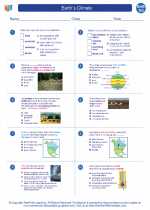Feedback Mechanisms in Earth Science
Feedback mechanisms are fundamental processes that help maintain balance in Earth's systems. These mechanisms involve the response of a system to an input, which can either amplify or dampen the effects of the input. In Earth Science, feedback mechanisms play a crucial role in regulating various processes within the atmosphere, hydrosphere, biosphere, and geosphere.
Types of Feedback Mechanisms
There are two main types of feedback mechanisms: positive feedback and negative feedback.
Positive Feedback
Positive feedback occurs when the initial change in a system triggers a series of events that amplify the change. This can lead to destabilization and potentially dramatic outcomes. An example of positive feedback in Earth Science is the melting of polar ice caps. As ice melts, it reduces the Earth's albedo (reflectivity), which in turn leads to more absorption of solar radiation, further enhancing the warming and ice melting.
Negative Feedback
Negative feedback, on the other hand, occurs when the initial change in a system triggers a response that counteracts the change, thereby maintaining equilibrium. An example of negative feedback is the regulation of body temperature in humans. When the body temperature rises, sweat is produced, which evaporates and cools the body, thus reducing the temperature.
Importance of Feedback Mechanisms
Understanding feedback mechanisms is crucial in Earth Science as they influence various processes such as climate change, ocean circulation, and ecosystem dynamics. These mechanisms help in stabilizing Earth's systems and maintaining a relatively stable environment for life to thrive.
Study Guide
Here are some key points to include in your study guide for feedback mechanisms:
- Define feedback mechanisms and their role in Earth's systems.
- Explain the differences between positive and negative feedback.
- Provide examples of positive and negative feedback in Earth Science.
- Discuss the importance of understanding feedback mechanisms in the context of environmental changes.
- Explore how feedback mechanisms impact climate, ocean currents, and ecological interactions.
- Consider the implications of feedback mechanisms on human activities and the environment.
By understanding and mastering the concept of feedback mechanisms, you will be able to analyze and appreciate the intricate balance that exists in Earth's systems and the potential impacts of environmental changes.
[Feedback Mechanisms] Related Worksheets and Study Guides:
.◂Earth Science Worksheets and Study Guides High School. Earth`s Climate

 Worksheet/Answer key
Worksheet/Answer key
 Worksheet/Answer key
Worksheet/Answer key
 Vocabulary/Answer key
Vocabulary/Answer key
 Vocabulary/Answer key
Vocabulary/Answer key
 Vocabulary/Answer key
Vocabulary/Answer key
